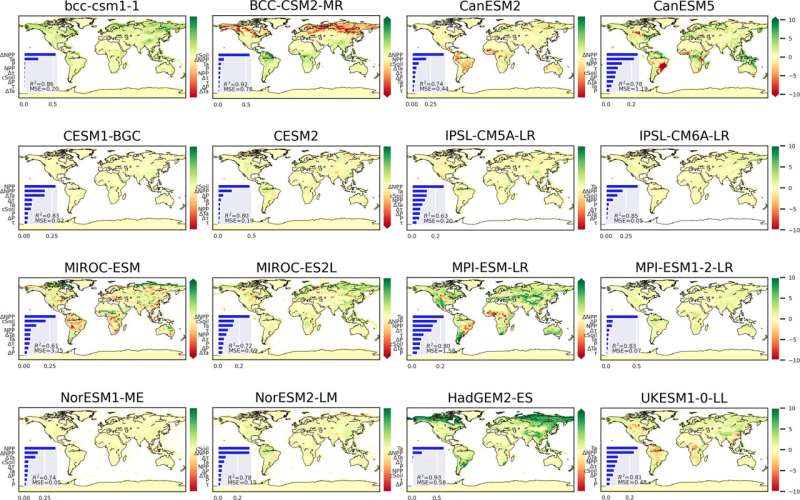Global distribution of soil organic carbon change for eight models present in both Coupled Model Intercomparison Project and CMIP6. Credit: AGU Advances (2024). DOI: 10.1029/2023AV001068
Soil carbon is exactly what it sounds like: carbon collected and stored in soil. Plants pull carbon from the atmosphere during photosynthesis and deposit it into the soil as their leaves, stems, and roots decompose. In fact, soil contains more than three times as much carbon as the atmosphere.
Scientists are uncertain, however, about how soil carbon storage responds to climate change. Increased carbon dioxide (CO2) in the atmosphere could lead to more plant growth and a resulting increase in soil organic carbon. On the other hand, studies have shown that climbing temperatures can cause soil to release its carbon into the atmosphere.
Earth system models help researchers understand how Earth and its inhabitants are contributing to and affected by climate change. But their projections are not necessarily reliable for estimating changes in soil organic carbon.
Zheng Shi and colleagues examined the reliability of soil carbon predictions in the outputs of 24 Earth system models. The researchers used two generations of models available through the Coupled Model Intercomparison Project: CMIP5 and CMIP6. The study is published in the journal AGU Advances.
Seventeen out of 24 models predicted gains in global soil organic carbon under high emission scenarios by 2100, with a mean rise of 43.9 petagrams—or 43 billion metric tons. Eleven of the 17 predicted a rise in soil organic carbon of more than 50 petagrams. Two models predicted large soil carbon losses of more than 50 petagrams, whereas soil carbon levels remained relatively constant globally in the five remaining models.
Particularly among CMIP5 results, large differences in soil carbon predictions across models raised questions about accuracy and reliability. Although global soil carbon changes in CMIP6 were much less variable, the models came up with similar results for very different reasons. This inconsistency suggests that there is not yet a true consensus among models—an issue for scientists and policymakers working to prepare for a warming planet.
The researchers suggest that future models should take updated biological and physical observations into account. Microbial activity, changes in permafrost, and fire patterns in tundra and tropical regions all affect the amount of carbon released into the atmosphere as CO2 instead of being stored as carbon in soil. Along with rising temperatures, these factors also have serious implications for the future of soil carbon in a changing climate.
More information: Zheng Shi et al, Global‐Scale Convergence Obscures Inconsistencies in Soil Carbon Change Predicted by Earth System Models, AGU Advances (2024). DOI: 10.1029/2023AV001068
Provided by Eos
This story is republished courtesy of Eos, hosted by the American Geophysical Union. Read the original storyhere.
























